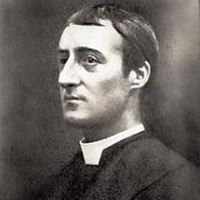Pied Beauty by Gerald Manley Hopkins: Summary and Analysis
Pied Beauty is a curtal sonnet by Gerald Manley Hopkins published posthumously in 1918 though written in 1877. Though most of the Victorian poets deal with the theme of frustration, anxiety, decay, loss of human values and faith, Gerard Manley Hopkins is the only one poet who finds hope in God. So, human faith and god's grandeur are the common themes of his writing.

Gerard M. Hopkins (1844-1889)
In this short poem, Hopkins appreciates the strength of the god in the universe. All the things in the universe contain the pied beauty. Sky does have the couple color, trout are spotted and chestnut does have the multiple color. Different trades do have the different purpose and different instruments have different tunes. In addition, the landscape is pieced, plotted, fold, follow and ploughed. Multiplicity and pied beauty can be seen in the landscape and the things of this universe. Not a single thing resembles with the other. Then pied beauty is the dominant feature of this universe and for this pied beauty he gives glory to god because god is the only source or father of all these things. Taking this glory of God into account, Hopkins asks mankind to praise him, then all the problems of the universe can be resolved peacefully.
Hopkins has a different form. He says every poem must have inscape and should be in design. The distinct design makes poem a poem. For that reason, he uses the rhythm as sprung rhythm. Sprung rhythm is a poetic pattern resembling to general speech with each foot having one stressed syllable that is followed by changing the number of unstressed syllables. Sprung rhythm does not follow the traditional metrical pattern rather its pattern is the pattern of themes which means it carries the theme. Here, pied beauty itself is the theme. Somewhere there is internal rhyme which is sprung rhythm and brings the theme of the poem. The design of the poem corresponds to the design of the universe.
His curtal sonnet is an exceptional sonnet where he minimizes the traditional form of a sonnet by reducing the eight lines in six and the six lines sestet into four and a half. Multiplicity is there in the pattern, somewhere there is alliteration. The repetitions of the sounds in the poem through the words like 'dappled', 'stipple', 'tackle', 'fickle', 'freckled', 'adazzle' etc. reinforces the theme of the poem by intertwining the diverse things of the nature created by the god into a beautiful and comprehensible whole.
The ending of the poem has juxtaposition. The vicissitude of his creations and their continuous flux in nature is juxtaposed with the changeless nature of God. This provides a mild irony in the poem and also surprises the readers. The speaker just wants all the people to praise the lord for his variety of creations.
The poem can be taken as a form of hymn of creation. The poet praises the variety and beautiful things of the world which are fathered by the god. By praising the creation, he praised the almighty god. He glorifies the infinite power of God to create the vicissitudes of things and also for the power to bring uniformity despite the diversity.
Related Topics
God's Grandeur: Summary and Analysis
The Windhover: Summary and Analysis
Spring and Fall: Summary and Analysis
Gerard Manley Hopkins: Biography
 |
bachelorandmaster.com |